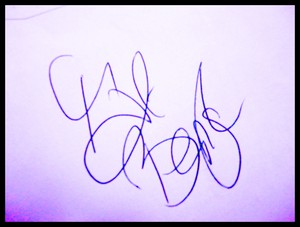Prepare, prepare, prepare
Brukar ni åxå roa er med att träna på autografer när ni har tråkigt?


How to Create Your Signature
Step 1
Write your name. Not just once or twice, do it say, 50 to 100 times. Most people will notice a loss of definition in certain letters or some interesting squiggles in a longer name when they compare the first signature to the last. These places are prime opportunities to simplify a long or complex autograph for ease of use.
Step 2
Try out several variations of your name: include or exclude a middle name, use an initial in place of your first, middle or last name or use a nickname or pseudonym instead of your legal name. For instance, few people may know who Romain De Tirtoff was, but many recognize the name Erté; this "nickname" came from the French pronunciation of his initials.
Step 3
Look for "signature" characters in your handwriting. Everyone recognizes the "W" and "D" in Walt Disney's signature because of the little loops he formed with each letter. Identifying letters you do exceptionally well or adding a flourish to the beginning or end of your name will make it all the more recognizable. This is especially true for the more public signatures like those of artists.
Step 4
Practice your autograph until it becomes both second nature and speedy. Imagine you have a line of folks standing at a table, all wanting their books signed, and the store's about to close. You don't want to disappoint them, but you want to keep your autograph consistent from a brand standpoint. Speed and familiarity make both of those things possible.


How to Create Your Signature
Step 1
Write your name. Not just once or twice, do it say, 50 to 100 times. Most people will notice a loss of definition in certain letters or some interesting squiggles in a longer name when they compare the first signature to the last. These places are prime opportunities to simplify a long or complex autograph for ease of use.
Step 2
Try out several variations of your name: include or exclude a middle name, use an initial in place of your first, middle or last name or use a nickname or pseudonym instead of your legal name. For instance, few people may know who Romain De Tirtoff was, but many recognize the name Erté; this "nickname" came from the French pronunciation of his initials.
Step 3
Look for "signature" characters in your handwriting. Everyone recognizes the "W" and "D" in Walt Disney's signature because of the little loops he formed with each letter. Identifying letters you do exceptionally well or adding a flourish to the beginning or end of your name will make it all the more recognizable. This is especially true for the more public signatures like those of artists.
Step 4
Practice your autograph until it becomes both second nature and speedy. Imagine you have a line of folks standing at a table, all wanting their books signed, and the store's about to close. You don't want to disappoint them, but you want to keep your autograph consistent from a brand standpoint. Speed and familiarity make both of those things possible.
Kommentarer
Trackback
